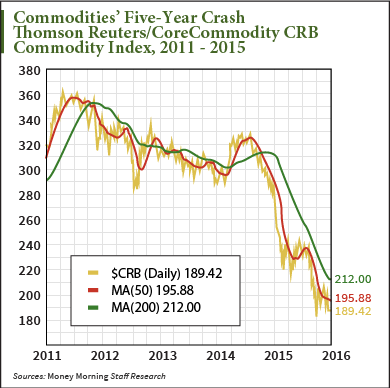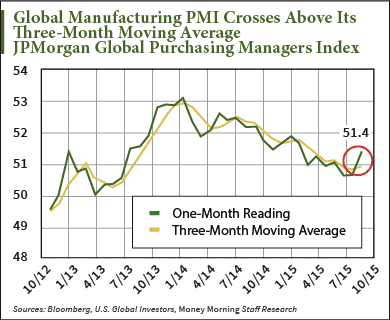Commodities prices have essentially crashed.
The Thomson Reuters/CoreCommodities CRB Commodity Index peaked near 365 in 2011. Today it sits at just 189, a brutal loss of more than 48%. Gold, silver, oil, natural gas, uranium, coal, iron ore, and copper are all at or near multiyear lows.
It's been devastating for companies producing them and countries dependent on exporting them.
But by definition, commodity production is a cyclical business, and what goes down simply must come up.
 In fact, there's so much upside potential at the other end of this sector-wide slump that my eyes have been glued to some important indicators - including some that few others are looking at.
In fact, there's so much upside potential at the other end of this sector-wide slump that my eyes have been glued to some important indicators - including some that few others are looking at.
When a bottom and recovery develops, it will appear here first. That will give us the earliest opportunity to capture gains on the way up.
I really like what I see right now. Let me show you...
Commodities Recovery Indicator No. 1: When the Big Buyers Are Buying
One significant indicator is the JPMorgan Global Purchasing Manager's Index (PMI).
Fund managers U.S. Global Investors Inc. (Nasdaq: GROW) track the global PMI carefully because it has historically anticipated the direction of commodities months in advance.
According to U.S. Global Investors, "when a PMI 'cross-above' occurs - that is, when the monthly reading crosses above the three-month moving average - it has signaled a possible spike in certain commodities, materials, and energy. Three months following previous breakouts, copper had an 81% probability of rising approximately 7%, while crude oil jumped 7% about three quarters of the time."
That's powerful stuff. And here's how it looks on a chart.
What's more, U.S. Global says commodities gain sufficient momentum to surge ahead when U.S., Europe, China, and global PMI readings all print above 50.0, "with the one-month readings above the three-month trends."
So far, only China has yet to cross above 50.0, though it has been trending higher in the last couple of months, reaching 48.3 in October.
We'll keep a close eye on just when that final signal comes in.
Commodities Recovery Indicator No. 2: The Investor "Herd Mentality"
Another relevant indicator has to do with sentiment - but it's not what you think.
You see, the investing crowd typically is a great predictor of doing the right thing at exactly the wrong time. That makes market sentiment a great contrarian indicator.
One of the best measures of this comes from research service Sentimentrader.com. The company has developed a proprietary "Optix" indicator that it applies to the CRB Commodity Index.
In December last year, the CRB Optix dipped below 30. That level has tended to mark the beginning of an inflection point in the CRB index.
We could still be looking at several months before a final bottom is in, but this is one more strong indicator that the end of the commodities rout is nigh.
Commodities Recovery Indicator No. 3: The Guru Effect
A third, more anecdotal kind of indicator is the "guru effect."
That's when big name investors buy into a particular sector because not only are the deals too good to resist, but they also believe that it's oversold and on the cusp of turning higher.
[mmpazkzone name="in-story" network="9794" site="307044" id="137008" type="4"]
Over the last few months, we've witnessed several exciting examples of this kind of action.
In July, it was reported that Seth Klarman of the Baupost Group had added nearly $500 million worth of Pioneer Natural Resources (NYSE: PXD) to his portfolio.
Then in late August, we got news that Warren Buffett had acquired a large stake in oil refiner Phillips 66 (NYSE: PSX). That brought his stake to 58 million shares, representing 10% of the company.
With, at the time, a P/E ratio of just 10, a return on equity of 19.34%, and a dividend yield of 2.83%, it wasn't hard to see what Buffett liked so much about Phillips 66.
Also in August, activist investor Carl Icahn bought 8.5% of the world's No. 2 copper producer Freeport-McMoRan Inc. (NYSE: FCX), spending $900 million on that position.
According to Bloomberg Business, Icahn's firm filed a regulatory notice indicating his intention to buy as much as 25% of the company.
Within weeks, Icahn was back in the news for taking an 8% stake in Cheniere Energy Inc. (NYSE: LNG) worth around $1 billion.
And Icahn's not alone on Cheniere. Other star investors with serious stakes in the company include no less than Seth Klarman, Julian Robertson, and Steven Cohen.
To be sure, the "guru effect" doesn't automatically make for a safe bet. Instead, it points to clues about their current thinking and indicates to other investors where some hidden value may lie.
It's too soon to call a definite bottom, but right now, it looks increasingly likely companies that produce and process resources may be ripe for investment.
The PMI, sentiment, and guru effect are all pointing towards potentially tremendous upside for commodities. Now that you know what to look for, you'll be ready for when these indicators start to flash a clear "Buy" signal.
Join the conversation: Follow Money Morning on Twitter and Facebook.


